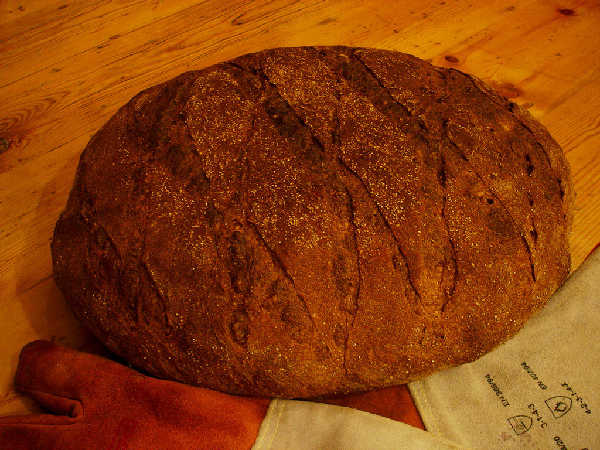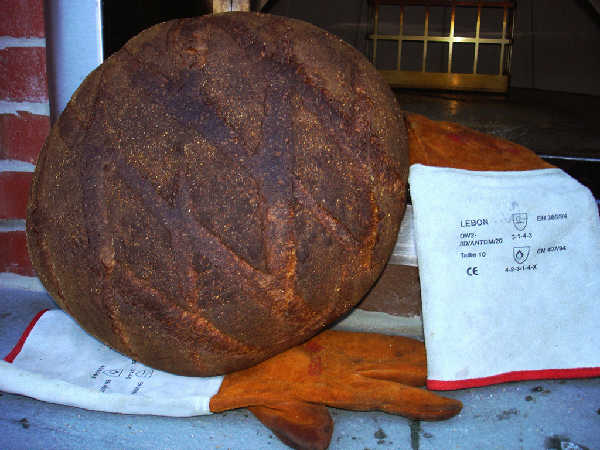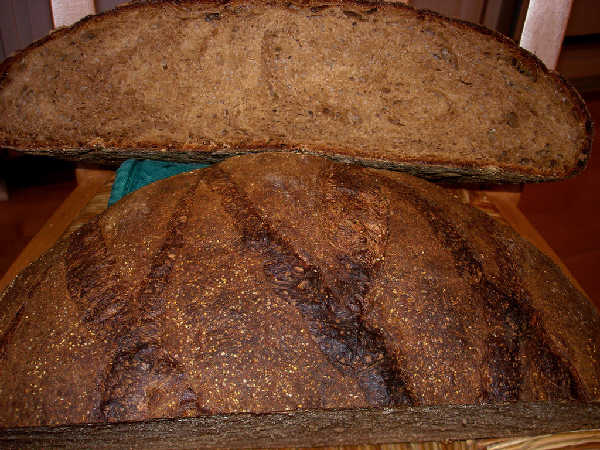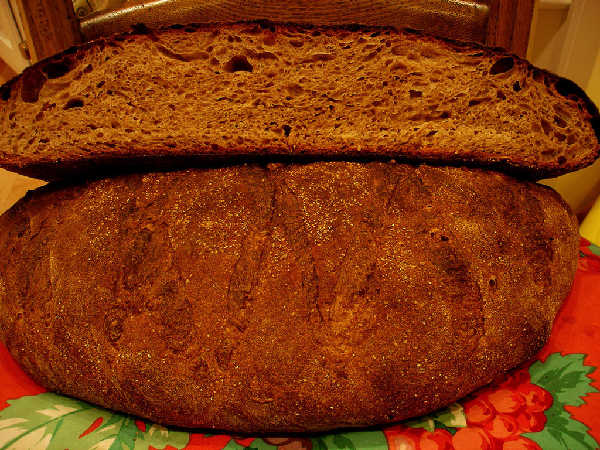
First Try
The first bread from my home milling and sifting project, blogged earlier, looked like a 100% whole wheat bread. Unfortunately, I still hadn't figured out a way to do home ash content testing, but from the results, a guess at the ash content of the flour that went into my first try might have been something like 1.4%. So, it had some of the darker material sifted from it and therefore had a lighter crumb than a 100% whole wheat flour might have produced, but the color and flavor was closer to 100% whole wheat.
Second Try

My second try was a little lighter but still closer to whole wheat in character. I allowed the sifting process to go on longer and used a couple of passes. After one pass through the Retsel mill at a fairly fine grind and then sifting through a stack of sieves (#25,35,45,60,70,80) on my sieve shaker, the breakout was as follows. A video of the equipment in operation is posted for fun.
| Sieve Size | Amount | percent | description |
| #25 | 25g | 4% | bran |
| #35 | 42g | 6% | middlings and bran |
| #45 | 70g | 10% | middlings |
| #60 | 107g | 15% | middlings and flour |
| #70 | 63g | 9% | cream flour |
| #80 | 99g | 14% | cream flour |
| thru #80 | 311g | 43% | white flour |
| total | 717g | 100% |
I then created a flour that is about 82% extraction by combining the all the flour that fell through the #60 sieve on the first pass with enough of the flour that fell through the #60 sieve on the second pass to constitute 82% of the total output. The resulting flour was lighter than on my first try, but the bread that resulted still had a color more like a whole wheat bread, although slightly lighter in color. The flavor was noticeably different, though. The second try had a flavor with far less of the grassy flavor of a whole wheat bread. Again, this flour was made before I had a way to test for the ash content, but I imagine from the color of it, that it was probably about 1.25% ash content. It was slightly darker than Heartland Mill Golden Buffalo flour. My second bread also had 5% whole rye and 10% whole spelt in it, as did the first one, so part of the whole wheat character of these loaves is caused by the addition of 15% whole grain flour.

Third Try
I received my Meadows 8 Inch Stone Mill and decided to have another go at milling and sifting. Of course, the new mill works differently than the Retsel. The stones are much larger and turn much faster. I can't seem to get the grind anywhere near as fine as the Retsel will produce with just one pass. However, the Meadows mill is far faster, especially when re-milling flour. The Retsel takes forever to re-mill flour, and seems to heat up too much on a second milling. The Meadows Mill takes less than a minute to grind a few cups of grain, and re-milling the output takes only slightly longer.
I was happy to discover that for the amounts I would normally do - not more than a 5 pounds at a time, the flour was very cool coming out of the mill. In fact, it was noticeably cooler in temperature than the flour coming out of the first pass with the Retsel mill. I imagine that equation would reverse for much larger amounts, as the Meadows would heat up over time to a higher temperature, given the large stones turning at much higher revolutions per minute.
This time I went for about a 70% yield. I realize in retrospect that my first pass was probably too coarse, which resulted in only about 600 grams going through the #60 sieve and 323 grams caught in the #25 sieve, out of a total output of 1815g. I then re-milled the middlings from that sifting, and the output was 350g through the #60 sieve. One more pass resulted in an output of another 244g through the #60 sieve. The flour coming through the #60 sieve from this pass was lighter than previous attempts.
I did another sample of about 300g which was milled at the finest settings a couple of times. The result was a finely milled whole wheat, more like what would be done on a very fine first pass with the Retsel. The result was sifted through a #25 and 50 sieves to get 240g of flour, with only 15g of "bran" caught in the #25 sieve and middlings of only 40g. This was probably too fine. I'm slowly beginning to understand what setting of coarseness of the mill will result in a good distribution of particle sizes for more efficient sifting to get the flour desired.
The resulting flour was actually 68% of the total flour made during this session trying a couple of different strategies. This time, I was able to measure the ash content, at least approximately, using the home ash content measurement mentioned in a previous blog entry. The ash content is around 1.05%, maybe a little lower than Heartland Mills Golden Buffalo flour, which their site says is around 1.13% ash content and I calculated to be around 1.2 with my test, such as it is.
Resulting Bread

A similar bread to previous attempts was made with this flour. However, I omitted the 10% spelt and raised the hydration to about 81% to compensate. I may have gone a little too far with the hydration, as I had some trouble getting the loaf to hold its shape well. Due to some unanticipated distractions, the loaf was about 20 minutes late getting into the oven, so it was also slightly overproofed. The result was therfore flatter than I would have liked. However, the crumb, crust, and flavor were all very good. I believe this loaf is very similar in most ways to country miches made with Heartland Mill Golden Buffalo flour in the past. The color is a little darker, but I believe that has more to do with the fact the flour is not aged, as the ash content clearly indicated that my flour was lower in conductivity than the Golden Buffalo flour and should therefore be a little closer to white flour than the Golden Buffalo flour. The texture of the dough and the general behavior of the flour while handling it seemed very similar to what I have experienced with the Golden Buffalo flour. By the way, the wheat berries used for this flour was Heartland Mills M2, which may be similar to the wheat berry product they are using to create the Golden Buffalo flour. Overall, I'm extremely happy with this result. The flavor and freshness of the home milled flour is a delight, and the prospect of being able to freshly mill a desired grade of flour on demand is pleasing.
Future Attempts
Now that I have a better feel for the right mill settings, my plan is to do a multiple pass approach, this time hopefully more systematically and with better mill settings. The outputs of the various passes will be saved and ash content measurements performed on each one. Hopefully, I can then make the process much more efficient and flexible. With ash content measurements available, blends can be created based on ash content of the final flour desired, and hopefully better yields will result for the same ash content, with better coarseness settings on the mill on the first and subsequent passes.
No comments:
Post a Comment
Note: Only a member of this blog may post a comment.